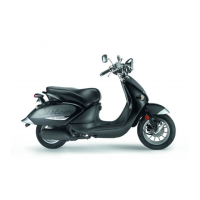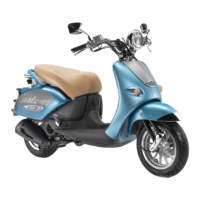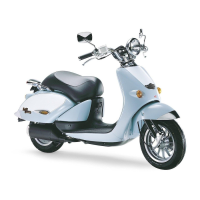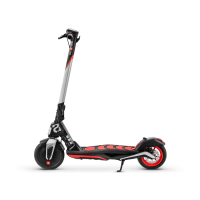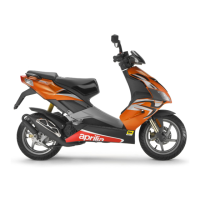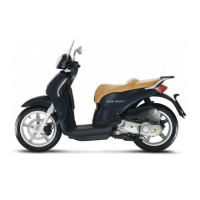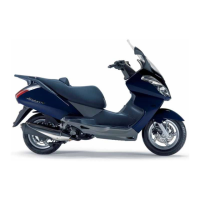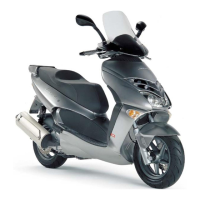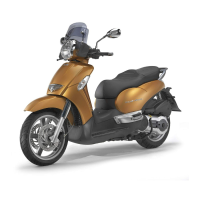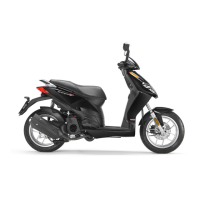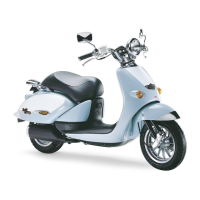
Do you have a question about the APRILIA MOJITO 150 - MANUEL 2 and is the answer not in the manual?
Warning about placing the ignition switch in the locked position while moving.
Explains the meaning of different warning symbols used in the manual.
Precautions for operating the engine in ventilated areas to avoid carbon monoxide poisoning.
Safety guidelines for handling flammable and poisonous gasoline.
Caution about hot engine and exhaust system parts after operation.
Warnings about toxicity, corrosivity, and proper handling of brake fluid.
Precautions regarding flammable, poisonous, and attractive nature of coolant.
Warnings about explosive gases and corrosive/poisonous electrolyte from the battery.
Specifies that the vehicle is designed for paved roads only, not off-road use.
Specifies warranty conditions, applicable regulations, and coverage periods based on displacement.
Emphasizes following instructions for rider and vehicle safety and longevity.
Stresses the necessity of wearing a helmet, gloves, eye protection, jacket, and sturdy footwear.
Stresses checking brakes, clutch, transmission, and throttle before starting.
Warns against riding under the influence of alcohol or drugs, which increases accident risk.
Advises against riding when tired, ill, or under the influence of substances.
Recommends training from organizations like the Motorcycle Safety Foundation.
Emphasizes observing all road rules, regulatory, and informational signs.
Avoids showing off, observes speed limits, and yields to automobiles.
Notes that motorcycles offer less protection than cars, and leg guards may increase injury risk.
Emphasizes giving full attention to riding and avoiding distractions like smoking or eating.
Advises using specified fuels/lubricants and regularly checking fluid levels.
Warns about the danger of a sticking throttle and the procedure to kill the engine.
Warns against riding a damaged vehicle due to instability and increased accident risk.
Warns against engine modifications for horsepower, which can cause damage and accidents.
States that tampering with emission/noise systems is illegal and subject to penalties.
Advises using both brakes together for even deceleration and avoiding sudden braking.
Recommends using engine braking and sparingly applying brakes downhill.
Advises riding gradually and smoothly in wet or slippery conditions.
Recommends gradual throttle use and avoiding engine lugging or over-revving.
Warns that aggressive cornering can lead to loss of traction and accidents.
Advises observing speed limits and adjusting speed for road conditions.
Warns against tampering with emission systems due to environmental impact and penalties.
Advises wearing bright reflective clothing to be more visible to other drivers.
Emphasizes wearing a crash helmet due to the high risk of fatal head injuries.
Warns that inappropriate accessories or overloading can cause instability and accidents.
Warns against overloading the vehicle and advises on proper load distribution.
Explains how carrying a passenger affects handling, brakes, and center of gravity.
Warns against abrupt acceleration/braking when carrying a passenger.
Warns that overloading reduces stability and maneuverability, leading to accidents.
Describes how to lock the steering and the associated key removal positions.
Critical safety warnings for handling fuel and the procedure for refueling the vehicle.
Safety advice for handling engine oil, including skin contact and disposal.
Instructions for topping up the 2-stroke oil tank and related cautions.
Guidance on checking and topping up engine oil, including using quality oils.
Advice on brake fluid level checks, potential system issues, and proper disposal.
Emphasizes brake system importance, checking for cleanliness, fluid level, and pad wear.
Step-by-step guide to checking the brake fluid level in the reservoir.
Advises checking brake pad wear and replacing if worn below indicators.
Stresses the importance of brake condition and provides instructions for adjusting rear drum brake clearance.
Emphasizes periodically checking tyre inflation pressure at room temperature.
Advises checking tyre surface and wear, and replacing worn tyres.
Warns about the catalytic silencer becoming extremely hot and potential fire hazards.
Warns that leaded petrol destroys the catalytic converter.
States that tampering with the noise control system is illegal and prohibited by law.
Stresses the importance of performing preliminary checks before departure for safety.
Warns about the extreme toxicity of carbon monoxide in exhaust gases.
Advises against starting the vehicle in closed or poorly ventilated rooms.
Step-by-step guide for starting the engine using the electric starter.
Warns against pressing the starter when the engine is running to avoid starter damage.
Explains the engine oil pressure light behavior after the engine starts.
Step-by-step guide for starting the vehicle using the kick starter.
Procedure for purging a flooded engine by using the starter without load.
Advice for starting the engine in very low ambient temperatures.
Steps for moving off, including throttle, brake, and stand use.
Warns against quick departure with a cold engine and suggests warming it up.
Recommends using both brakes for even deceleration and avoiding single-brake use.
Advises reducing speed before curves, avoiding full braking, and maintaining constant speed.
Warns against continuous braking downhill and suggests using engine compression.
Advises low speed, smooth inputs, and caution on wet or slippery surfaces.
Advises indicating lane changes in advance and switching off indicators promptly.
Advises caution when overtaking and notes reduced visibility in rain due to mist.
Specifies checks required after the initial 312 miles to ensure safety and prevent damage.
Specifies checks required after the initial 625 miles to ensure safety and prevent damage.
Stresses the importance of running-in for engine life, performance, suspension, and brakes.
Outlines limits for braking and throttle usage during the first 312 miles of driving.
Provides specific precautions for the MC150 model regarding throttle use and running-in.
Advises against sudden stopping and hard braking, and describes the procedure for stopping.
Emphasizes parking on firm, flat ground and ensuring hot components are not a danger.
Warns against leaving the vehicle unguarded with the engine running or key in ignition.
Advises locking the steering and removing the key when stationary.
Warns against using brake lock devices due to potential damage and accidents.
Emphasizes never leaving the ignition key in the switch and always using the steering lock.
Warns of burn hazards from hot engine and exhaust components.
Step-by-step instructions for checking the engine oil level using the dipstick.
Instructions for topping up engine oil, including adding small quantities and checking the level.
Warnings about not overfilling or letting the oil level drop too low.
Warns against using contaminated or improper lubricants, which can damage the engine.
Advises cleaning and checking the air cleaner monthly or every 2500 mi (4000 Km).
Warns against using petrol or flammable solvents for cleaning the filter.
Advises cleaning and checking the air cleaner monthly or every 3750 mi (6000 Km).
Advises checking brake pad wear after initial mileage and at regular intervals.
Steps for visually checking brake pads and discs for wear.
Specifies when to replace brake pads based on wear indicators or thickness.
Warns about metallic noise and sparks caused by excessive pad wear.
Advises checking rear brake shoe wear at specified intervals and contacting dealer if indicator is on.
Step-by-step guide to checking steering slack using a support.
Advises adjusting idling after initial mileage or when irregular.
Specifies the required slack for the accelerator control relative to the handlebar.
Warns to ensure handlebar rotation does not affect idling and throttle returns smoothly.
Advises checking spark plugs after initial mileage and replacing them at specified intervals.
Details on cleaning the spark plug, checking for deposits, corrosion, and cracks.
How to check and adjust the spark plug electrode gap using a thickness gauge.
Importance of the washer and correct spark plug tightening torque for engine health.
Warns about fire hazards when handling fuel near electrical components.
Correct procedure for connecting and disconnecting battery cables to avoid component damage.
Warnings about battery electrolyte being toxic, caustic, and causing burns.
Warns that batteries emit explosive gases and require ventilation and distance from ignition sources.
Advice on handling skin contact, eye contact, and ingestion of battery fluid.
Steps for checking and cleaning battery terminals and clamps for good condition.
Steps for checking the electrolyte level between MIN and MAX marks.
Warns to use only distilled water and not to overfill the battery.
Steps for installing the battery, including connecting cables and applying grease.
Specific steps for installing the battery on the MC150 model.
Warns against repairing fuses and using incorrect types, which can cause damage or fire.
How to replace a blown fuse with one of the same rating and check the cause.
Instructions for adjusting the vertical headlight beam using a screwdriver.
Steps for adjusting the horizontal headlight beam by loosening nuts and adjusting angle.
Warns of fire hazards when handling fuel near electrical components during bulb replacement.
Instructions for replacing the low/high beam bulb, including connector and clip removal.
Warns against draining the fuel tank, which can damage components.
Warns against towing the vehicle with another vehicle.
Advises transporting the vehicle in a vertical position, tied down, with wheels blocked.
Warns about temporarily impaired brake function after washing and advises drying them.
Warns against using high-pressure washers, steam cleaners, or air jets due to potential damage.
Details precautions to prevent negative effects from not using the vehicle.
Warns to let the engine and exhaust cool down before carrying out operations.
Recommends carrying out preliminary checks before riding the vehicle after storage.
Advises a test ride at moderate speed in low-traffic areas after storage.
Warns to use new brake fluid only and not to mix different brands without ascertaining compatibility.
